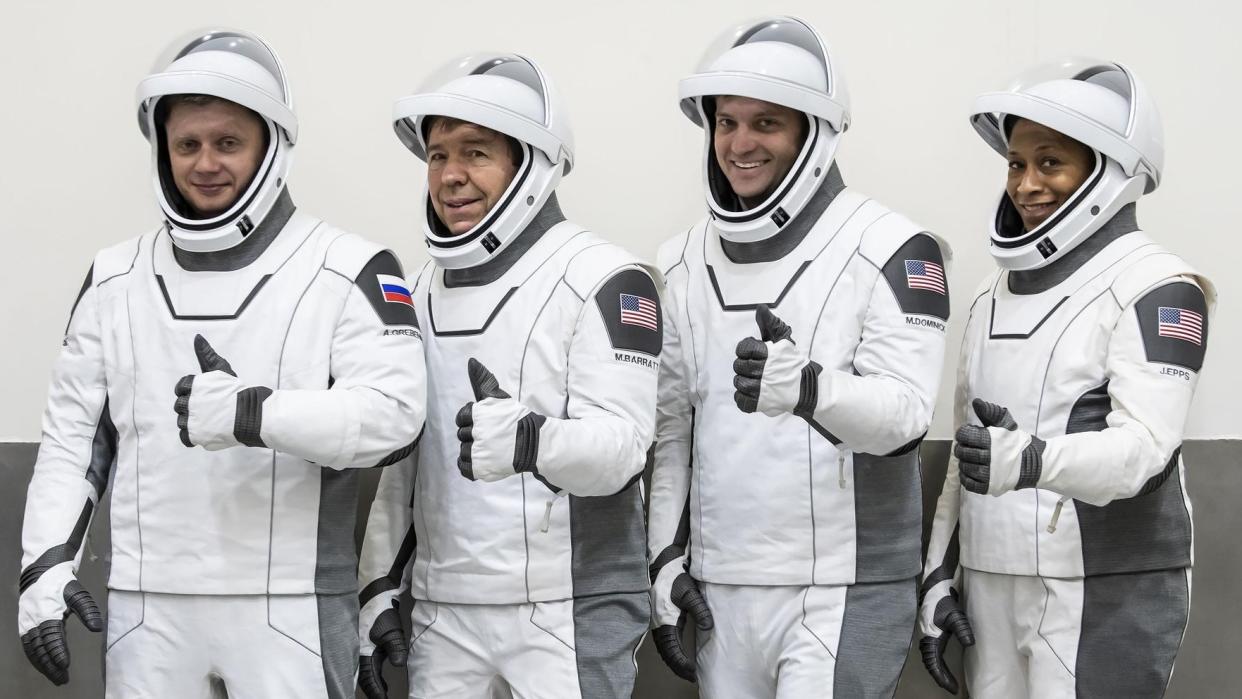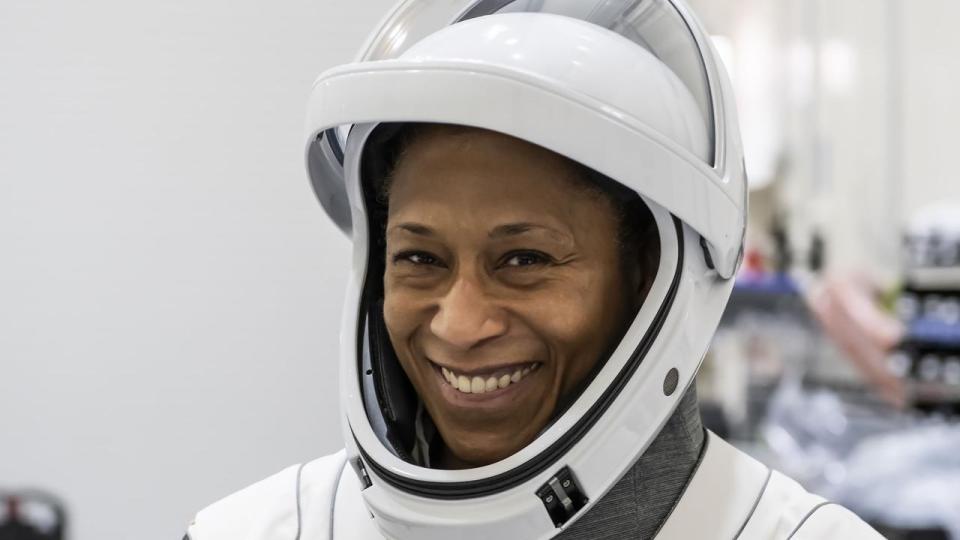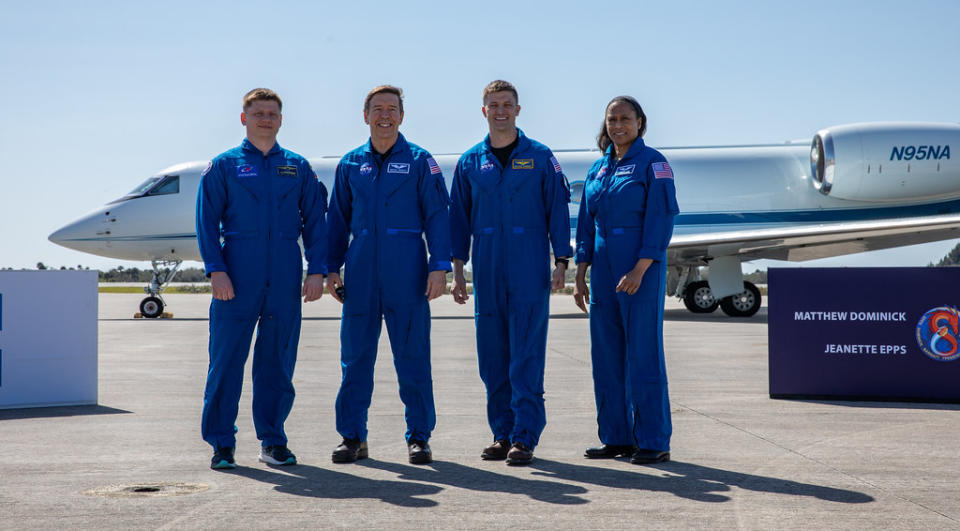SpaceX Crew-8 astronauts eager for launch to ISS on March 1: 'Things surprise you, but we're ready'

- Oops!Something went wrong.Please try again later.
- Oops!Something went wrong.Please try again later.
- Oops!Something went wrong.Please try again later.
- Oops!Something went wrong.Please try again later.
A new set of astronauts are ready for an International Space Station launch.
SpaceX is set to launch four new astronauts on the Crew Dragon spacecraft for Crew-8, the eighth operational commercial crew mission for NASA, to the International Space Station no earlier than Mar. 1.
Crew-8 includes NASA astronauts Matthew Dominick (commander), Michael Barratt (pilot), and Jeanette Epps (mission specialist), along with mission specialist Alexander Grebenkin, of the Russian space agency Roscosmos.
All of the crew are rookies aside from Barratt, who is on his third trip following flights in 2009 (ISS Expeditions 19-20) and 2011 (the space shuttle's STS-133). Epps was previously assigned to two other missions on Russia's Soyuz and Boeing's Starliner spacecraft, but was reassigned from both for various reasons.
Related: NASA selects astronauts for SpaceX Crew-8 mission to International Space Station

The crew's personal mementos are, as often the case in these missions, callbacks to meaningful moments and people in their lives. The four shared their plans to carry a few small things during a livestreamed Crew-8 press conference at NASA's Johnson Space Center in Houston, on Jan. 25.
Dominick plans to loft a watch that he said is similar to what the astronauts wore during Apollo moon missions (the astronauts used Omega Speedmasters). This watch is one he received from his father, who has held it since 1970. The two used to time their road trip distances between mile markers using that watch, he shared.
Among Barratt's mementos will be "hardcore photos" (printed out photos) of his family, while Epps will bring up a photo of her mother. "Five days after I was selected (as an astronaut candidate), my mom passed away," added Epps, who joined NASA in June 2009. "I wouldn't be here if it wasn't for her, and her work ethic and her emphasis on education growing up."

Space.com spoke with three of the four astronauts individually on Jan. 25 to learn more about their spaceflight or spaceflight-related experiences. (Epps was unavailable.)
One of Barratt's most "attention-getting events of my life" happened during STS-133 in February 2011, he shared, when Canadarm2 froze in place while spacewalking NASA astronaut Stephen Bowen was mounted on the robotic arm. "I'm fine as long as it's not too much longer," Bowen told the space shuttle crew. Barratt was one of the group controlling the arm from a workstation inside the Cupola — a 360-degree set of windows allowing for ideal views of robotic activities.

The cupola controls for Canadarm2 were not working, according to the NASA spacewalk history book "Walking to Olympus." But switching to a backup Canadarm2 station in the U.S. Destiny laboratory quickly solved the issue. Although the science hub was tucked further inside the ISS and away from the big windows, Barratt said this scenario showed that backups are always useful. "Things surprise you, but we're ready for those surprises for the most part," he said.
While Dominick has yet to fly to space, the Navy pilot is well-known around the Astronaut Office for organizing astronauts to buzz the Artemis 1 rocket in 2022, before that mission flew a human-rated capsule with mannequins around the moon. Artemis 1 was the debut moon mission of the greater Artemis program that aims to put humans on the moon again no earlier than 2026.
RELATED STORIES:
— NASA selects astronauts for SpaceX Crew-8 mission to International Space Station
— Russians will fly on SpaceX's Crew-7, Crew-8 astronaut missions: report
— NASA orders 3 more SpaceX Crew Dragon flights to space station
The resulting pictures of the astronaut group in T-38 trainers beside Artemis 1's Space Launch System rocket "are all over the Kennedy Space Center and Johnson Space Center", Dominick shared in a small-group interview with Space.com on Jan. 25, although his training schedule did not allow him to take part personally. The photos were enhanced in true NASA planning fashion: Dominick and his team used software to figure out the right time to fly for good lighting angles from the sun.
Grebenkin, a pilot for the Russian armed forces, said he is enjoying the challenge of learning the systems aboard the SpaceX Dragon capsule alongside his previous training with Soyuz.
When asked about key differences, he said through an English-language interpreter that it's not only about learning a new vehicle, but "getting accustomed a new training approach" with American instructors instead of Russian. While Grebenkin did not elaborate on the international differences, he added that most Russian training time for cosmonauts is devoted to learning how to operate the Soyuz spacecraft.
